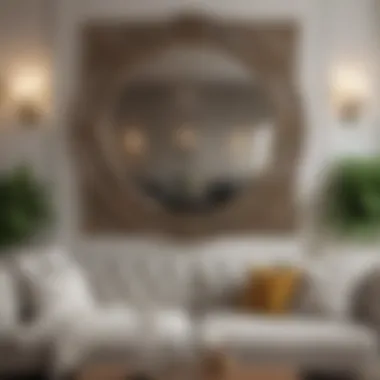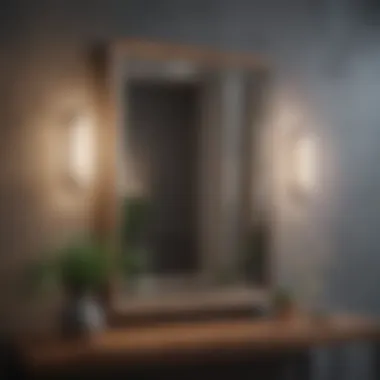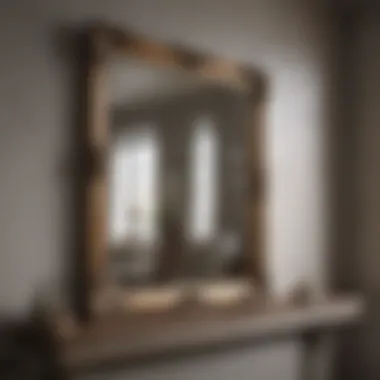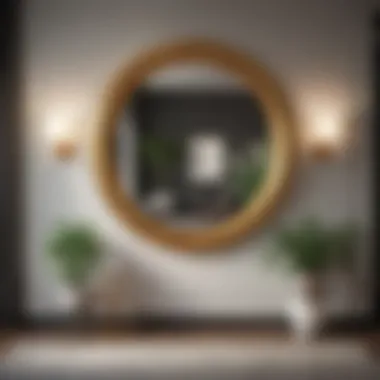Enhancing Living Rooms with Fancy Wall Mirrors


Intro
Fancy wall mirrors serve more than just a functional purpose in living rooms. They merge aesthetics with utility, creating spaces that feel larger and more inviting. This exploration will delve into the various aspects that make these mirrors a significant element in home decor. From their design inspirations to practical maintenance tips, understanding these components will elevate your living space’s style and functionality. In this guide, we aim to provide insights that will assist homeowners and design enthusiasts alike in making informed choices regarding their wall mirrors.
Design Inspirations
Trending Styles
The variety of styles available in wall mirrors caters to diverse tastes and home decor themes. Some popular trends include:
- Mid-century Modern: Characterized by clean lines and organic shapes, this style embraces functionality while maintaining a rich aesthetic.
- Industrial: These mirrors often feature metal frames and raw finishes. They can seamlessly blend into loft-style living rooms, enhancing the overall rustic appeal.
- Bohemian: Known for eclectic designs, bohemian wall mirrors often incorporate natural materials like rattan and wood. These mirrors add warmth and a personal touch to vibrant spaces.
- Contemporary: Sleek designs with minimalistic features define contemporary mirrors. They often emphasize simplicity, making them a suitable choice for modern living rooms.
Understanding which style resonates with your living room can significantly impact its overall atmosphere. Choose mirrors that not only match your personal taste but also harmonize with existing decor elements.
Color Palettes
The color of a wall mirror can greatly influence the room’s ambiance. Here's how to consider color palettes:
- Neutral Tones: Colors like white, beige, or gray are timeless choices. These tones can complement almost any decor style, providing flexibility.
- Bold Hues: Deep blues, greens, or reds can serve as focal points in a room. If you want the mirror to stand out, consider vibrant frames.
- Metallics: Gold, silver, or bronze finishes can add a touch of luxury. These options reflect light effectively, making a space feel more spacious and airy.
- Nature-Inspired Colors: Earthy shades derived from nature create a relaxing vibe. This can be particularly effective in spaces designed for comfort, such as living rooms.
By thoughtfully selecting colors that resonate with your design ethos, you can enhance the visual effect of wall mirrors in your living spaces.
Maintenance and Upkeep
Fancy wall mirrors, while visually appealing, require proper maintenance to ensure their longevity and clarity.
Seasonal Maintenance Checklist
Periodically reviewing your mirrors is essential. Consider this simple checklist:
- Inspect for Damage: Look for chips or cracks that need repair.
- Check for Loose Fixtures: Ensure that the mirror is securely fastened.
- Dust Regularly: Accumulated dust can dull the surface.
Such checks can prevent minor issues from developing into larger problems.
Cleaning and Organization Tips
Maintaining the clarity of your wall mirrors is vital. Here are some effective strategies:
- Use a Soft Cloth: A microfiber cloth is ideal for streak-free cleaning.
- Gentle Cleaners: Opt for ammonia-free glass cleaners to avoid damage. Alternatively, a mixture of vinegar and water works effectively.
- Organize Surrounding Decor: Ensure other decor elements around the mirror do not obstruct its view. This keeps the focus on its elegance and functionality.
Adhering to these cleaning and organizational strategies maintains the mirror's beauty while enhancing your living room's overall aesthetic.
"A well-placed mirror can transform a room, adding light and depth to your living space."
Through careful consideration of design inspirations and consistent maintenance, fancy wall mirrors can elevate the elegance and functionality of any living room, making them a worthy investment.
Prologue to Wall Mirrors
Wall mirrors serve a dual purpose in living rooms: they enhance the aesthetic appeal while improving functionality. They reflect light and, when placed strategically, they can make a room feel larger. This introduction seeks to establish the foundation for understanding the significance of fancy wall mirrors in contemporary interiors.
Defining Fancy Wall Mirrors
Fancy wall mirrors, unlike basic or utilitarian mirrors, incorporate design elements that elevate their status from mere reflective surfaces to striking decor pieces. These mirrors often feature intricate frames, unique shapes, and aesthetic arrangements that can complement or contrast with a room's decor. The combination of their reflective qualities and artistic design makes them vital for any well-considered living space. For instance, a large, ornate mirror can act as a focal point in a room. Different styles, such as rustic, vintage, or modern, cater to diverse tastes and preferences, making them versatile additions to any interior design scheme.
Historical Context of Mirrors in Interior Design
Mirrors have a long-standing role in interior design, dating back to ancient civilizations. Initially, mirrors were made from polished stones and later transitioned to glass. By the 16th century, Venice became famous for producing high-quality glass mirrors, which were highly sought after. The use of mirrors evolved from practical applications to decorative ones, reflecting the artistic movements and social conditions of their time. In the 18th century, mirrors grew in significance, often adorning the walls of grand palaces and homes, serving both functionality and as symbols of wealth and status. Today, this rich history informs the styles and choices available in the market, influencing the way contemporary designers incorporate mirrors into living spaces.
"The evolution of mirrors over time signifies their transformation from mere objects of utility to significant elements of decor that can shape the character of a space."
Understanding these fundamentals sets the stage for discussing the various types of fancy wall mirrors and their role in enhancing living rooms further.
Types of Fancy Wall Mirrors
Understanding the types of fancy wall mirrors is crucial as they play a significant role in enhancing both aesthetics and functionality within living rooms. Each type of mirror brings its unique contribution to the space, whether it be through adding visual interest, creating focal points, or increasing the perception of space. Selecting the right type will depend on individual style preferences, complementary decor, and practical considerations.
Framed Mirrors
Framed mirrors are one of the most popular choices among homeowners due to their versatility and style variety.


Wood Frames
Wood frames offer warmth and texture to a living room. They are often chosen for their timeless appeal and ability to complement various styles, from rustic to modern. A significant characteristic of wood frames is their natural grain and finish, which adds depth and richness to any decor. They can be stained, painted, or left natural, making them adaptable to personal style. One potential disadvantage is that they may require more maintenance to prevent warping or damage from humidity.
Metal Frames
Metal frames confer a sleek and contemporary look. They can add sophistication and elegance to a living space. A key trait of metal frames is their durability; they are resistant to wear and tear, providing longevity in a space. Moreover, the finish can range from brushed nickel to polished brass, making it easy to coordinate with existing fixtures and accents. However, metal frames can sometimes feel cold or impersonal if not balanced with other warm elements in the room.
Decorative Frames
Decorative frames elevate mirrors to a statement piece in the room. They feature intricate designs, which allows homeowners to express their personal style boldly. The unique features of decorative frames can include ornate carvings, vibrant colors, or unusual silhouettes. They are beneficial for creating a focal point but may overwhelm simpler decor if not used thoughtfully.
Unframed Mirrors
Unframed mirrors bring a modern simplicity to living rooms, often allowing for greater versatility in decor. They can serve as a clean backdrop while enhancing the openness of the area.
Edge-to-Edge Designs
Edge-to-edge designs create an illusion of greater space. This minimalist approach highlights the reflective quality of the glass. The primary advantage is their seamless look, allowing them to integrate smoothly into contemporary decor. However, because there are no frames, the edges can be more sensitive to chipping or damage over time.
Floating Styles
Floating styles create a unique visual effect, making the mirror appear as though it is hovering on the wall. These mirrors often come with minimal mounting hardware that camouflages the attachment, which contributes to their aesthetic appeal. One key benefit is that they can adapt to various setups while maintaining a light and airy feel in the room. On the downside, their installation might require more precision and care to achieve the desired floating effect.
Vintage and Antique Mirrors
These mirrors invoke a sense of history and nostalgia. Vintage and antique mirrors can add character and charm to a living room. Their unique features often include intricate details and unusual shapes that tell a story. These mirrors can become conversation starters and significantly influence the overall ambiance. Their main disadvantage is that they may require more careful handling and maintenance due to their age.
Contemporary and Modern Mirrors
Contemporary and modern mirrors reflect current design trends. They often incorporate innovative materials and styles. These mirrors prioritize functionality while embracing sleek lines and unique shapes. A notable aspect of contemporary mirrors is their ability to fit into various color palettes and styles, making them highly versatile. Nevertheless, they may lack the vintage charm that some homeowners seek.
Materials Used in Wall Mirrors
The materials used in wall mirrors significantly influence both aesthetics and functionality. A mirror's effectiveness is often determined by the type of glass, backing materials, and framing components. Understanding these elements is crucial for homeowners and design enthusiasts aiming to select a mirror that complements their space while providing practical benefits.
Glass Types
Regular Glass
Regular glass is the most commonly used material in wall mirrors. It is favored for its affordability and clarity. The main characteristic of regular glass is its smooth surface, which reflects images accurately. This type of glass is accessible and works with a variety of framing styles, making it a flexible choice for many décor themes.
A unique feature of regular glass is its lightness. This allows for easier handling and installation. However, one disadvantage is its vulnerability to breakage. It is important to consider this factor, especially in households with children or pets. Therefore, while regular glass is a popular option, careful placement is essential.
Specialty Glass
Specialty glass, on the other hand, is designed for enhanced performance. This type of glass includes options such as tempered glass, which is heat-treated to improve strength and safety. The key characteristic of specialty glass is its increased durability. For those seeking a combination of elegance and practicality, this is a beneficial choice.
The unique feature of specialty glass is its resistance to shattering, making it safer for high-traffic areas. However, it often comes at a higher price point compared to regular glass. The investment can be worthwhile for those prioritizing longevity and safety in their interior design.
Mirror Backing Materials
The backing of a mirror is just as important as the glass itself. Common materials used for backing include silver, aluminum, and stainless steel. Each material affects the quality of reflection and durability. Silver-backed mirrors tend to provide a brighter, clearer image. However, they can be more susceptible to tarnishing over time.
Aluminum is popular for its resistance to corrosion, particularly in humid environments, making it a smart choice for bathrooms. Stainless steel, although more expensive, offers exceptional durability and a modern look. Choosing the right backing material is pivotal in determining the mirror's longevity and performance.
Frame Materials and Their Impact
The materials used in the frame of a wall mirror not only contribute to its overall look but also play a role in its stability. Common frame materials include wood, metal, and plastic. Wood frames offer warmth and a classic appeal, fitting well in traditional or rustic designs. However, they can be prone to warping in humid conditions.
Metal frames, including those made from brass or iron, lend a contemporary edge and are often more durable. They can easily blend into modern décor. Plastic frames, while less expensive, often mimic the look of pricier materials. Though they are lightweight, the aesthetic can vary significantly based on design.
Design Considerations for Living Rooms
When one thinks about the placement of mirrors in the living room, considerations stretch beyond mere aesthetic appeal. This segment of the article will clarify the significant elements that influence the effectiveness of fancy wall mirrors in these settings. The interplay between proportions, color schemes, and overall style cohesion impacts how guests perceive the space. Functioning as a nodal point, mirrors can enhance elegance while optimizing utility.
Proportions and Scale
Understanding proportionality is vital when selecting a wall mirror for the living room. Not only should the mirror reflect elements of style, but it should also complement the dimensions of the wall and surrounding furniture. A large mirror may dominate a small wall, making the room feel unbalanced, while a small mirror may be dwarfed by expansive walls or large furniture pieces.
- Measure Before You Buy: Take accurate measurements of both wall height and width to determine an appropriate size.
- Consider Eye Level: Ideally, mirror placement should be at eye level for optimal visual access.
- Exploit Vertical Space: In rooms with high ceilings, tall mirrors can draw the eye upward, enhancing spatial perception.


A balance between the size of the mirror and the room's scale can guide how one perceives the atmosphere and organization. Large, ornate mirrors can add luxury, while smaller mirrors might offer a more casual touch.
Color Schemes
The choice of colors in the surrounding environment serves as a backdrop to the mirror's role in the room. Mirrors can reflect and amplify colors, hence influencing the overall ambience. It is important to consider:
- Complementary Tones: Select mirrors with frames that harmonize with the base colors of walls, furniture, and decorative elements.
- Contrast for Interest: Sometimes, contrasting colors can create an engaging focal point, pushing the boundaries of conventional design principles.
- Mood Influence: Lighter colors can brighten spaces, while darker frames can add a sense of depth and sophistication.
When thoughtfully integrated, mirrors can enhance color schemes outlined in broader design plans, making them integral to a cohesive living room aesthetic.
Style Cohesion
Every living room reflects the personality and style of its owner. Therefore, mirrors must fit seamlessly into this narrative. This involves choosing mirrors that resonate with existing furnishings and themes.
- Identify the Dominant Style: Is the room modern, traditional, rustic, or eclectic? The mirror should blend with these traits rather than stand out like an afterthought.
- Frame Design Matters: A vintage frame might fit perfectly in a classic setting, while a sleek, frameless mirror suits minimalist environments.
- Proportionally match with Decor: The style of existing decor, including light fixtures and artwork, should guide the mirror choice.
In short, mirrors can significantly enhance style cohesion. They can tie together diverse design elements for a harmonized space. Through careful consideration of proportions, color schemes, and style, mirrors serve not only as reflective surfaces but as key components in living room aesthetics.
Placement Strategies
The choice of placement for fancy wall mirrors in living rooms plays a critical role in their effectiveness. It influences not only the aesthetic aspect of a room but also its spatial dynamics. The right mirror placement can enhance the beauty of the living space, while poor placement can lead to a disjointed look. This section explores several key factors in mirror placement that contribute to maximizing both elegance and functionality.
Height and Angle of Placement
Selecting the appropriate height for a mirror is crucial. Ideally, the center of the mirror should align with the eye level of the people using the space. This makes the reflection more engaging and allows for its full functionality. Mirrors placed too high or too low can distort perceptions and diminish their intended impact. Likewise, the angle at which the mirror is mounted can change the light distribution in a room. A slight tilt upwards can reflect more light from overhead fixtures, whereas a downward tilt may limit visual openness. Properly adjusting the angle can create an inviting and well-lit atmosphere.
Positioning to Enhance Space
Positioning mirrors strategically can open up spaces and create depth within a room. This is especially applicable for smaller living rooms, where space optimization is essential. A well-placed mirror can trick the eye into perceiving a larger area. This section discusses two approaches within this category.
Creating Illusions of Space
Creating illusions of space involves using mirrors to expand visual boundaries. When placed opposite a window, mirrors can reflect natural light, making a room feel more expansive and brighter. Moreover, mirrors reflect existing decor, adding complexity and vibrancy. Their shiny surfaces can help break up heavy furniture arrangements or accent walls.
Key characteristic: Using mirrors in this way is a popular choice because it adds a dimension beyond mere decoration; it serves as an optical enhancement.
Unique feature: The way mirrors can multiply visual elements in a room is enticing, yet homeowners should be cautious. Overusing mirrors might lead to confusion in space perception or overcrowding of visual stimuli.
Combining with Lighting
Combining mirror placement with effective lighting strategies bolsters the elegance of a living room. Well-placed mirrors enhance illumination by reflecting light sources. This can create a balanced and inviting ambiance. Light fixtures near mirrors result in a glow that uplifts the entire room.
Key characteristic: This combination becomes a nurturing choice for any interior. Their reflective properties bring life and dimensionality to any dull area.
Unique feature: However, it’s essential to ensure that mirrors reflect flattering light. A mirror reflecting harsh lighting or clutter can create a disagreeable visual. Careful thought must be put into which lights to position near mirrors for achieving the best result.
Mirrors are not just decorative elements; they function as tools of design, influencing perception and flow within any space.
Utilizing effective placement strategies can transform a living room into a space defined by both elegance and functionality. Whether enhancing light, creating visual depth, or embodying artistic styles, mirrors have an integral role in contemporary interior design.
Functional Benefits of Mirrors
Mirrors serve more than a decorative purpose in living rooms. They augment both beauty and practicality within interior spaces. Their functional benefits can significantly enhance the overall experience and effectiveness of a living room. This section examines two key advantages of incorporating mirrors: visual expansion of space and light reflection and distribution.
Visual Expansion of Space
One of the most appreciated functions of mirrors is their ability to create the illusion of a larger area. In smaller living rooms, this is often a crucial benefit. Placing a well-positioned mirror can create a sense of depth and openness. When light interacts with mirrors, it produces reflective surfaces that trick the eye into perceiving a broader space.
The strategic placement of mirrors across from windows or light sources can emphasize this effect. Homeowners often notice that a single large mirror can make an entire room feel more spacious. This is particularly useful in urban environments where space might be limited. The idea is simple: reflect what exists and double the perceived area, which helps in fostering both a livelier and airy feel.
Light Reflection and Distribution
Mirrors also play a significant role in light management within a room. A well-placed mirror can amplify natural light significantly. For instance, arranging a mirror to catch light coming through a window can help illuminate shadows in darker corners of a living room. This aspect not only enhances the brightness of the space, but it also contributes to a more inviting atmosphere.
Additionally, reflective surfaces can aid in evenly distributing artificial lighting. By positioning mirrors near fixtures or lamps, homeowners can ensure that light disperses throughout the room. This practical application improves both visibility and ambiance, highlighting decorative elements without harsh contrasts or dark spots.
"A strategically placed mirror can act as an architect of light, ensuring every corner of a living room feels alive and vibrant."
In summary, the functional benefits of mirrors are quite significant. They enhance aesthetic beauty while improving the livability of spaces. Homeowners and design enthusiasts alike can utilize these advantages to make thoughtful choices in their interior design, ensuring that mirrors do not merely serve a visual purpose but also contribute to a well-lit and spatially coherent living area.


Maintenance and Care for Wall Mirrors
Maintaining and caring for wall mirrors is essential to preserve their beauty and functionality in any living space. The right care helps to avoid damage, cleanliness loss, and can extend the lifespan of these decorative pieces. A well-maintained mirror not only reflects light beautifully but also enhances the overall aesthetic appeal of a room.
Proper maintenance ensures that mirrors remain an elegant addition to homes while fostering an eye-catching atmosphere. Engaging with mirrors through routine care highlights their worth in home decor and their role in shaping the feel of a living room.
Cleaning Techniques
Cleaning wall mirrors is a straightforward task, yet it must be performed with care to avoid streaks and scratches. Here are effective cleaning methods:
- Use of Gentle Cleaners: Mix equal parts of water and vinegar for a natural cleaning solution. Avoid harsh chemicals which can damage the reflective surface.
- Microfiber Cloths: Always opt for microfiber cloths. Unlike paper towels, they won’t scratch the surface and effectively lift dirt and grime.
- Circular Motions: When cleaning, use circular motions to wipe the surface. This technique helps avoid streaks, ensuring a clear reflection.
- Drying with Care: After cleaning, ensure the mirror is dried properly. Any excess moisture can lead to water spots.
Incorporating these techniques into your routine will keep your mirror shining and maintain its attractiveness.
Preventing Damage
Taking steps to prevent damage to wall mirrors is as crucial as cleaning them. Here are several considerations to keep in mind:
- Appropriate Placement: Avoid placing mirrors near direct sunlight. Prolonged exposure can cause fading or discoloration.
- Avoid Heavy Objects Nearby: Ensure that heavy items are not positioned above mirrors, as they can fall and cause shattering.
- Use of Proper Hanging Techniques: Opt for heavy-duty hooks when mounting mirrors. This ensures they are securely hung, reducing the risk of falls.
- Regular Checks for Loose Fixtures: Periodically check the wall mounts and fixtures. Loose installations can pose a risk of falling and breaking.
By adhering to these prevention measures, you can protect your wall mirrors from potential harm, thus maintaining their functional elegance.
Incorporating Accessories with Mirrors
Incorporating accessories with mirrors is a crucial aspect that influences both the aesthetic appeal and functional value of living rooms. The right accessories can highlight the mirror’s beauty, draw attention to a focal point, and create a cohesive look in the space. By selecting items that complement the style and color of the mirrors, homeowners can enhance their interior design significantly. This section delves into specific elements that can be paired with mirrors, the benefits these accessories provide, and important considerations when choosing them.
Frames and Surrounding Decor
Frames can greatly enhance the visual impact of mirrors. A carefully chosen frame can transform a simple mirror into a statement piece. Various styles, such as ornate gilded frames or sleek contemporary designs, can either contrast with or complement the existing decor in a living room. When selecting a frame, it is essential to consider the overall style of the room. For instance, a vintage mirror frame can introduce warmth and character to a modern setting.
Surrounding decor also plays a significant role in how mirrors function within a space. Decorative elements like shelves, wall art, or console tables can be arranged to create visual appeal around the mirror. This arrangement can draw the eye towards the mirror, enhancing both its presence and the room's ambiance. Functionally, placing a mirror above a console table or decorative shelf not only provides a visual extension but also serves practical purposes like checking one's appearance before heading out.
Complementary Artwork
Artwork surrounding a mirror can synergize beautifully to enhance the overall atmosphere of a living room. When choosing artworks, consider dimensions and themes that resonate with the mirror's design. For example, abstract paintings can add a modern touch, while classic oil paintings may complement a vintage mirror.
It is also beneficial to consider color harmony while selecting artwork. The hues in the paintings can echo the colors in the mirror's frame or its reflection, thus achieving a harmonious balance.
Important: Ensure that the artwork is hung at an appropriate height to maintain a proper line of sight with the mirror. This creates a seamless blend, allowing the mirror to reflect not just an image but the entire curated aesthetic of the room.
In summary, combining mirrors with well-thought-out accessories like frames and surrounding decor artfully enhances the elegance of a living room. This not only serves aesthetic purposes but also enhances the room’s functionality, effectively marrying beauty with practicality.
Trends in Mirror Design
The realm of mirror design has evolved significantly in recent years. This evolution is essential in understanding how fancy wall mirrors not only serve functional purposes but also act as key design elements in living rooms. Trends in mirror design reflect broader shifts in interior aesthetics, the push for sustainable practices, and the incorporation of technology. Knowing these trends allows homeowners and design enthusiasts to choose mirrors that resonate with current tastes while enhancing their living spaces.
Sustainable Materials in Mirrors
Sustainability is becoming a fundamental consideration in home décor. Many manufacturers are now focusing on eco-friendly materials to craft mirrors. This shift is driven by a growing awareness of environmental issues.
Using sustainable materials often means selecting mirrors made from recycled glass or frames that utilize reclaimed wood. These choices not only minimize the ecological footprint but also lend a unique character to each piece. Signs of this trend can be seen in various styles, from rustic to contemporary. Homeowners can contribute to environmental conservation while still embracing elegance in their living room décor.
Moreover, mirrors made from sustainable materials often come with certifications, ensuring their eco-friendly nature. Choosing such materials reflects a mindful approach to consumption, aligning personal style with broader ecological values.
Technological Innovations
The integration of technology into mirror design has opened new avenues for functionality and aesthetics. Smart mirrors, for example, are equipped with features that go beyond mere reflection. They can display weather updates, time, or even sync with home automation systems.
These mirrors often incorporate LED lighting, which not only enhances the ambient feel of a room but also creates excitement. The light can be adjusted for different moods, adding versatility to achieving the desired atmosphere. More advanced models may offer touch-screen capabilities, integrating media playback and skincare routines into daily life.
The rise of technology in mirror design is not just about utility; it signifies a trend where form meets innovation. Stylish designs combined with cutting-edge technology amplify the role of mirrors in modern living spaces. This evolution speaks to a broader cultural shift towards incorporating intelligent, responsive elements in home interiors.
The current trends in mirror design encapsulate a marrying of aesthetics with functionality that appeals to the discerning homeowner.
By embracing these innovations, individuals can enhance their living environments while staying attuned to the future of interior design.
Finale
Fancy wall mirrors play a critical role in enhancing the overall design and functionality of living rooms. They serve not only as decorative accents but also as practical tools that can drastically alter the perception of space and light. Their placement, size, and style must be carefully considered to ensure they complement the room's aesthetic while serving their intended purpose.
The lasting impact of mirrors in design is profound. They can create environments that feel more open and airy, contributing to a sense of spaciousness in smaller areas. This is especially important for homeowners with limited square footage who wish to maximize the visual appeal of their living spaces. Additionally, mirrors can effectively reflect light, making rooms appear brighter and more inviting.
The revitalization of design standards through mirrors also extends to their variety and personalization. With the vast array of styles—ranging from vintage to contemporary—homeowners can select pieces that echo their unique tastes. This enhances the character of the living room, allowing it to feel both elegant and welcoming.
Ultimately, the inclusion of fancy wall mirrors in interior design is about balancing elegance with functionality. Properly selected and placed mirrors can amplify aesthetic beauty, while also serving practical functions that improve lighting and spatial dynamics.
"A well-chosen mirror not only enhances visual dimensions but also reflects the personality of its owner."







